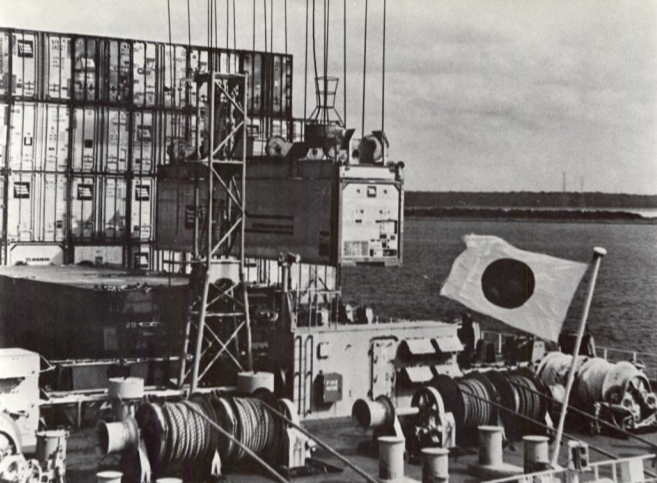In this edition from the March 1975 issue of American Shipper, FreightWaves shares an article discussing the resumption of citrus shipping from Florida to Japan after an embargo.
Japan grapefruit trade resumes
The Japanese embargo against fresh Florida citrus was lifted February 10, and ships began loading in three Florida ports at a rate indicating 1975 shipments may equal or surpass the 6,500,000 cartons of fresh fruit booked in 1974 before the embargo was placed.
Japan, anxious to protect citrus groves in the southern islands, placed the embargo against fresh fruit from Florida late last Spring when a cargo of grapefruit infested with Caribbean fruit fly larvae was discovered upon arrival of the ship in Japan. The infected fruit was destroyed.
Throughout the Summer and Fall, U.S. and Florida agriculture officials worked with the Japanese to develop fumigation procedures which would prevent recurrence of the 1974 incident. Fumigation centers were established in Fort Pierce, Lakeland, and Gainesville. With the U.S. Department of Agriculture providing enforcement through issuance of phytosanitary certificates, the Japanese government agreed to lift the embargo.
Within 10 days after the ban was raised, a total of 616,608 cartons of fruit had been loaded aboard ships at Port Everglades, Tampa, and Jacksonville. Other cargoes were being booked for Savannah and Port of Palm Beach. Largest single shipment was 220,000 boxes (40 lb. export cartons) loaded aboard the Salen Reefer Service’s S/S Edinburgh Clipper at Port Everglades on February 20.
Port Everglades
Eller & Company, stevedore and agent for the vessel, was making plans for a total of 11 Salen reefer ships to call at Port Everglades at the rate of one per week through the month of April. All fruit loaded at Port Everglades is fumigated at Fort Pierce prior to delivery to the port. Eller officials said continuation of shipments is contingent upon a good outturn upon receipt in Japan, but the precautions taken are expected to be adequate.
Each Salen ship scheduled at Port Everglades will find 220,000 cartons of fresh grapefruit waiting — a total anticipated move of 2,420,000 cartons.
Tampa. Eller & Company also has the movements through Tampa, where the company is agent and stevedore for Japan Reefer Line and J. Lauritzen Line reefer ships. Each service anticipates loading eight vessels in Tampa before the close of the grapefruit season, a total anticipated movement through Tampa of about 2,560,000 cartons of fruit.
Sailed February 17 with the first shipment of 140,000 cartons. Second vessel loading at the Ellerco Terminal was Lauritzen’s S/S Samoan Reefer with 180,000 cartons.
Remainder of the grapefruit going to Japan will move on Salen ships out of Port of Palm Beach, via Japanese Space Charter Group containerships from Jacksonville and Savannah, or by Mini-bridge service through the West Coast.
Jacksonville. Jacksonville’s first grapefruit loading was 76 containers aboard “K” Lines’ M/S Verrazano Bridge at Blount Island Terminal on February 17. Each container held 1,008 cartons of fruit, a total of 76,608 cartons on the vessel.
Approximately half of the Jacksonville fruit moved under “K” Line bill of lading, while the remainder was moved in the name of N.Y.K. Line, Japan Line, YS Line, or Mitsui O.S.K. Line.
With the next Japanese container ship scheduled at Jacksonville on March 26, shippers were booking container loads to go out aboard the M/S Japan Ambrose and M/S Tohbei Maru calling Savannah during the first week of March. (It was reported unofficially the Japanese container lines are re-arranging their schedules to avoid bunching ships at either South Atlantic port, indicating Japan Ambrose and Tohbei Maru could call at Jacksonville if cargo revenues justify.)
Fumigation
Fumigation service arrangements were worked out by the U.S. Department of Agriculture and Florida Division of Plant Industry. Containers and/or trucks laden with fresh fruit must remain inside fumigation chambers almost three hours. It requires 15 minutes to “charge” the chamber with chemicals, 2 hours to destroy all larvae, and 30 minutes to clear the chamber and permit removal of the unit.
The fumigation facility in Gainesville — where Jacksonville and Savannah cargoes are fumigated — has three chambers and a daily capacity to treat 27 containers. The center is committed to fumigate 6 containers daily for shippers to the West Coast, leaving a maximum capacity of 21 containers daily which can move via Jacksonville.
Charge for fumigation service is $50 per container, paid by the shipper.
The program is in charge of the Division of Plant Industry Director Hal Jones and his assistant director, Dr. S. A. Alfieni.
FreightWaves Classics articles look at various aspects of the transportation industry’s history. Click here to subscribe to our newsletter!
Have a topic you want me to cover? Email me at [email protected] or follow me on Twitter.










